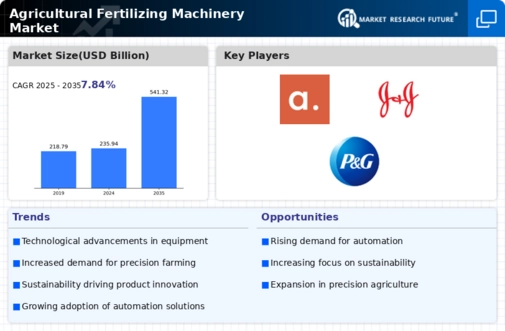Rising Food Demand
The Agricultural Fertilizing Machinery Market is significantly influenced by the rising global food demand, driven by population growth and changing dietary preferences. As the world population is projected to reach approximately 9.7 billion by 2050, the need for increased agricultural productivity becomes paramount. Fertilizing machinery plays a crucial role in enhancing crop yields, thereby addressing food security challenges. According to recent estimates, the agricultural sector must increase food production by nearly 70% to meet future demands. This scenario presents a substantial opportunity for the Agricultural Fertilizing Machinery Market, as farmers seek advanced machinery to optimize their output and ensure sustainable practices.
Environmental Regulations
The Agricultural Fertilizing Machinery Market is increasingly affected by stringent environmental regulations aimed at reducing the ecological footprint of farming practices. Governments and regulatory bodies are imposing limits on fertilizer usage to mitigate soil degradation and water pollution. This regulatory landscape compels farmers to invest in advanced fertilizing machinery that complies with environmental standards. For instance, machinery equipped with precision application technology can help minimize runoff and optimize nutrient delivery to crops. As compliance with these regulations becomes essential, the Agricultural Fertilizing Machinery Market is expected to see a shift towards more sustainable and environmentally friendly machinery solutions.
Technological Advancements
The Agricultural Fertilizing Machinery Market is experiencing a surge in technological advancements, which are revolutionizing the way fertilizers are applied. Innovations such as precision agriculture and automated machinery are enhancing efficiency and reducing waste. For instance, the integration of GPS technology allows for precise application rates, which can lead to a reduction in fertilizer usage by up to 20%. This not only lowers costs for farmers but also minimizes environmental impact. Furthermore, the adoption of IoT devices in agricultural machinery enables real-time monitoring and data collection, facilitating informed decision-making. As these technologies become more accessible, the Agricultural Fertilizing Machinery Market is likely to expand, driven by the demand for smarter, more efficient farming solutions.
Increased Investment in Agriculture
Increased investment in agriculture is a driving force behind the growth of the Agricultural Fertilizing Machinery Market. As investors recognize the potential for profitability in the agricultural sector, funding for innovative machinery and technologies is on the rise. This influx of capital enables manufacturers to develop and market advanced fertilizing equipment that meets the evolving needs of farmers. Moreover, the trend towards agritech startups is fostering innovation, leading to the introduction of cutting-edge solutions in the market. Consequently, the Agricultural Fertilizing Machinery Market is poised for expansion, as enhanced investment translates into improved machinery capabilities and greater adoption among farmers.
Government Initiatives and Subsidies
Government initiatives and subsidies are pivotal in shaping the Agricultural Fertilizing Machinery Market. Many governments are implementing policies aimed at promoting sustainable agricultural practices, which often include financial incentives for farmers to adopt modern fertilizing machinery. For example, various countries have introduced subsidy programs that cover a portion of the costs associated with purchasing advanced fertilizing equipment. These initiatives not only encourage the adoption of efficient technologies but also support farmers in enhancing their productivity. As a result, the Agricultural Fertilizing Machinery Market is likely to benefit from increased investments in machinery, driven by favorable government policies and support mechanisms.


















Leave a Comment